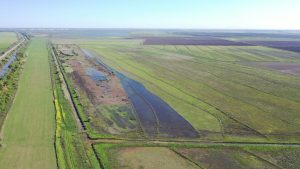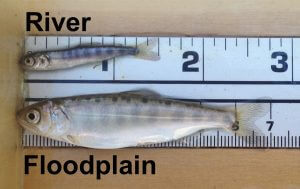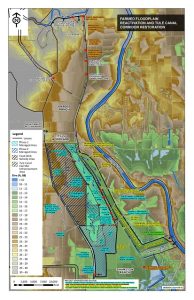By Byron Buck, Director of Natural Resources, Conaway Ranch
Reclamation District 2035 and the Conaway Preservation Group are proposing a project to improve and optimize flood plain rearing habitat, salmonid food production and permanent wetland restoration for Sacramento Valley salmonids. The project would involve nearly 5,775-acres of the Conaway Ranch in the Yolo Bypass, as seen below looking south down the Sacramento Valley, with the Tule Canal at left of photo.

As background, Conaway Ranch has been farmed since the early 1900s. The land was fully reclaimed around 1920, shortly after Reclamation District 2035 was formed. Initially, Conaway Ranch was dedicated to cattle ranching; however, by the late 1940s prospects for continued ranching were limited, and the property was leased for farming. Over the last twenty years and more, the Conaway Ranch has become engaged in a wide variety of wildlife-friendly farming activities including creation and enhancement of habitat for Swainson’s Hawk, Tri-Color Blackbird, and Giant Garter Snake, for which permanent wildlife easements have been granted to assure species protection and sustainability.
For more than ten years, Conaway has also been pursuing concepts to advance recovery and sustainability for endangered and threatened salmonid species, primarily investigating ideas that could allow for seasonal floodplain expansion to allow for increased salmonid rearing habitat and salmonid food production, as described below. The project allows for three subtypes of Salmonid enhancement: wet-side enhancements allowing for both fish rearing and food production, dry-side food production, and permanent wetland and river re-connection concepts. See Reactivating Floodplains in the Sacramento River Basin: How working lands on both sides of the levees are aiding fish and wildlife.
HOW IT COULD WORK
The owners of Conaway Ranch, working with Reclamation District 2035, are seeking funding of approximately $3.6 million to conduct a Design Development Study to provide a design, supporting permit authorizations and an operational strategy for an ultimate implementation project to provide increased inundation of approximately 5,775 acres of managed farmland within the Yolo Bypass to mimic natural floodplain habitat functions by providing rearing and resting habitat for juvenile salmonids and fry (restoration project). The study is proposed to occur in three general phases: 1) preliminary design and alternatives analysis, 2) alternatives review, environmental review (CEQA/NEPA), selection of preferred alternative and 30% design, and 3) final design of preferred alternative and permitting. The goal at the end of the study is to have a salmon restoration project that is ready for funding and construction. The intent of the study and resultant implementation project is to enhance and increase the ecological benefits of the combined USBR and the State of California DWR’s Yolo Bypass Salmonid Habitat Restoration and Fish Passage Project by taking advantage of the larger project’s flow regime.
The study would evaluate, refine and advance design to a construction-ready project with permits for the following conceptual components as shown in the graphical description below. The three project components are:
- Seasonal Salmonid Floodplain Habitat Restoration (Phase I and II)
- Seasonal Salmonid Food Production (Food Subsidy Area), and
- In-river Tule Canal Restoration and Wetland re-creation (Tule Corridor Enhancement Area).
The Salmonid Floodplain Restoration component would reconfigure rice farmland water control structures to pond water for seasonal flooding and remove impediments to volitional travel back to the Sacramento River by juvenile fish and provide access to over 2,675-acres of fields for rearing. The project takes advantage of water flowing into the Yolo Bypass through the new notch provided in the Yolo Bypass Salmonid Habitat Restoration and Fish Passage Project (Fremont Weir notch). The project will also provide fish food benefits to the Delta, aiding feeding of salmonids and other fish species resident within and migrating through the Delta.
The Salmonid Food Production component is an additional 2,800-acre area that would be seasonally flooded to grow micro invertebrates and other fish food to be released to the Sacramento River system, providing additional food sources to the lower Sacramento River and the Delta, aiding in the growth of native species.
The In-River Tule Canal component, similar to other restoration proposals adjacent to Conaway Ranch and upstream from the Ranch, would restore riparian habitat along the canal, increase sinuosity of the drainage and water supply channel and potentially expand off channel wetland habitat up to about 300-acres of permanent, annual wetland habitat. This would benefit the endangered Giant Garter Snake and other wetland species as well as promote food production for salmonids as well as provide feeding and rearing habitat for juvenile salmonids.
Studies over the past decade have demonstrably shown that migrating salmonids benefit from off stream rearing habitat where more food is available for them to grow prior to making their migration to the ocean. The fish grow larger and more robust, as shown below. Fish that are larger and more robust have higher survival rates and are more likely to return to spawn after their ocean maturation.

THE OPPORTUNITY
The owners of Conaway Ranch, working with Reclamation District 2035, are seeking about $3.6 million necessary to conduct a collaborative alternatives analysis and project selection permitting process that would result in a project available for construction. Total project implementation costs would vary by the ultimate components chosen to proceed and their final design but could range up to approximately $45 million for a full implementation of all components.
If you have any questions or would like additional information on Conaway Ranch, please contact me at byron@conawayranch.com.




